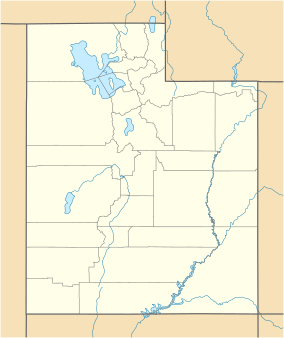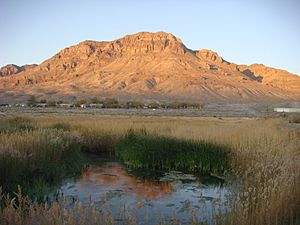Fish Springs National Wildlife Refuge facts for kids
Quick facts for kids Fish Springs National Wildlife Refuge |
|
|---|---|
|
IUCN Category IV (Habitat/Species Management Area)
|
|

Marsh land at Fish Springs National Wildlife Refuge
|
|
| Location | Juab County, Utah, United States |
| Nearest city | Dugway, Utah |
| Area | 17,992 acres (7,281 ha) |
| Established | 1959 |
| Governing body | U.S. Fish and Wildlife Service |
| Website | Fish Springs National Wildlife Refuge |
Fish Springs National Wildlife Refuge is a special place in Juab County, Utah, United States. It's like a green oasis in the middle of the Great Basin Desert, which is a very dry area. This refuge is managed by the United States Fish and Wildlife Service, an agency that protects wildlife.
Many different animals call Fish Springs home. You can find fish, migratory birds (birds that travel long distances), deer, coyotes, pronghorn, and even cougars here. It's also a fun spot for outdoor activities. The refuge is located near the Fish Springs Range, a mountain range that runs north to south.
Contents
What is Fish Springs National Wildlife Refuge?
Fish Springs National Wildlife Refuge is a protected area that helps keep nature safe. It's found at the southern edge of the Great Salt Lake Desert in Utah. This refuge is important because it provides water and shelter for many animals in a desert environment.
A Desert Oasis for Wildlife
Imagine a desert where water is hard to find. Fish Springs is different! It has natural springs that create wetlands, which are like marshy areas. These wetlands are a vital source of water for animals.
- Birds: Many types of birds stop here during their long migrations.
- Mammals: Animals like deer, coyotes, pronghorn, and cougars live here.
- Fish: The springs are home to fish, some of which are quite unique.
Getting to the Refuge
You can reach Fish Springs by driving. Part of the journey is on a paved road, and then it becomes an improved dirt road. This dirt road is actually part of the historic Pony Express Road/Lincoln Highway.
The History of Fish Springs
Fish Springs has a cool history! Before it became a wildlife refuge, it was an important stop for travelers.
- Pony Express Station: It served as a station for the Pony Express, where riders would change horses and rest.
- Overland Stage Station: It was also a stop for the Overland Stage, another way people traveled across the country long ago.
The name "Fish Springs" comes from the fish that lived in the springs. Early visitors reported seeing fish that were over 6 inches (15 cm) long!
The Amazing Springs of Fish Springs
The natural springs are what make Fish Springs so special. These springs bring water up from deep underground, creating the wetlands that support all the wildlife.
Where Does the Water Come From?
The water in these springs is very old! It's believed to be left over from an ancient lake called Lake Bonneville. This huge lake covered much of Utah about 14,000 years ago, but it dried up over time.
The water for Fish Springs travels a very long way underground. It starts in distant mountain ranges, like the Schell Creek Range and Snake Range. It flows through cracks and permeable rocks underground until it finally reaches the surface at Fish Springs. This means much more water flows out of the springs each year than falls as rain in the local valley!
The Many Springs
There are several natural springs at the refuge, all lined up along the base of the mountains. Some of the main springs include:
- North Springs
- Deadman Springs
- House Springs
- Middle Springs
- Thomas Springs
- South Springs
- Percy Springs
Water Quality
The water from Fish Springs is unique. It's usually warm, around 80 °F (27 °C), and it's quite salty. Because of this, it's not safe for people to drink. However, it's perfect for the plants and animals that call this desert oasis home!




